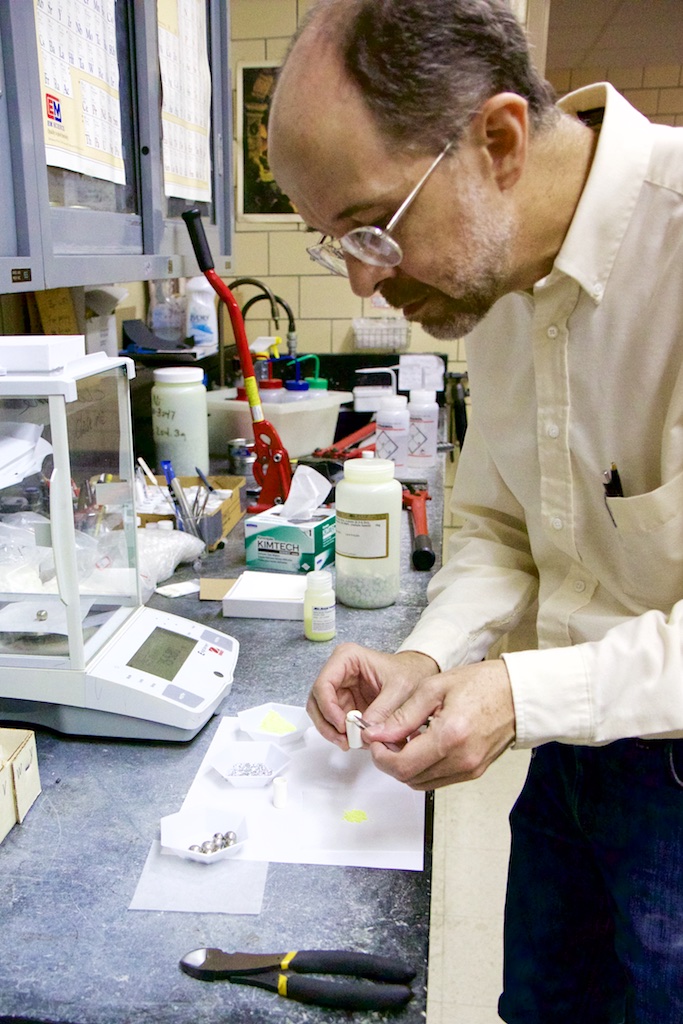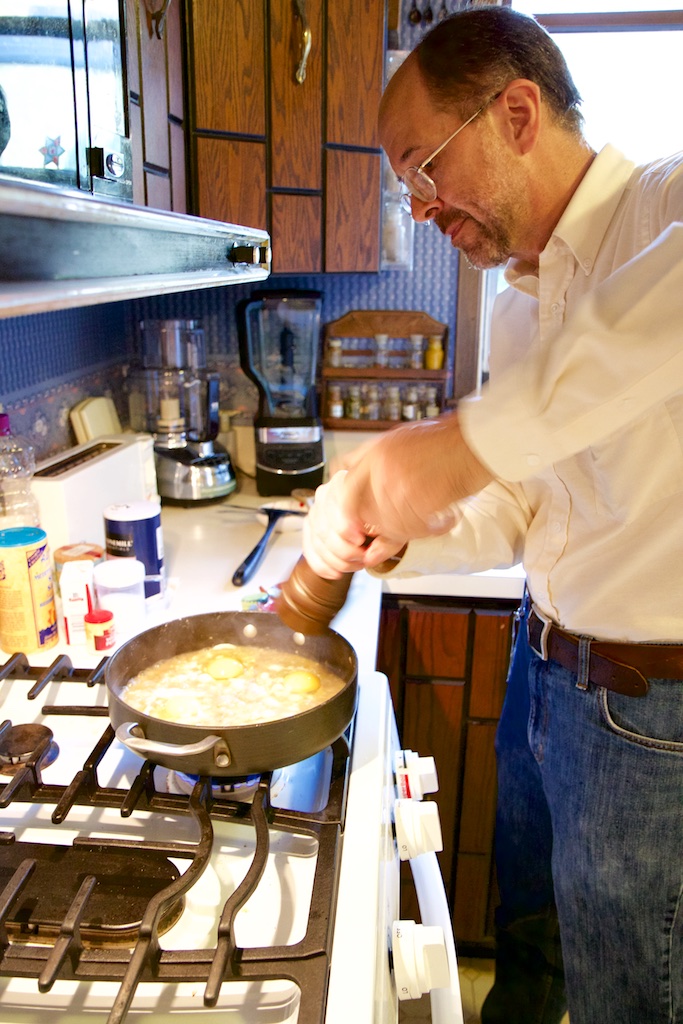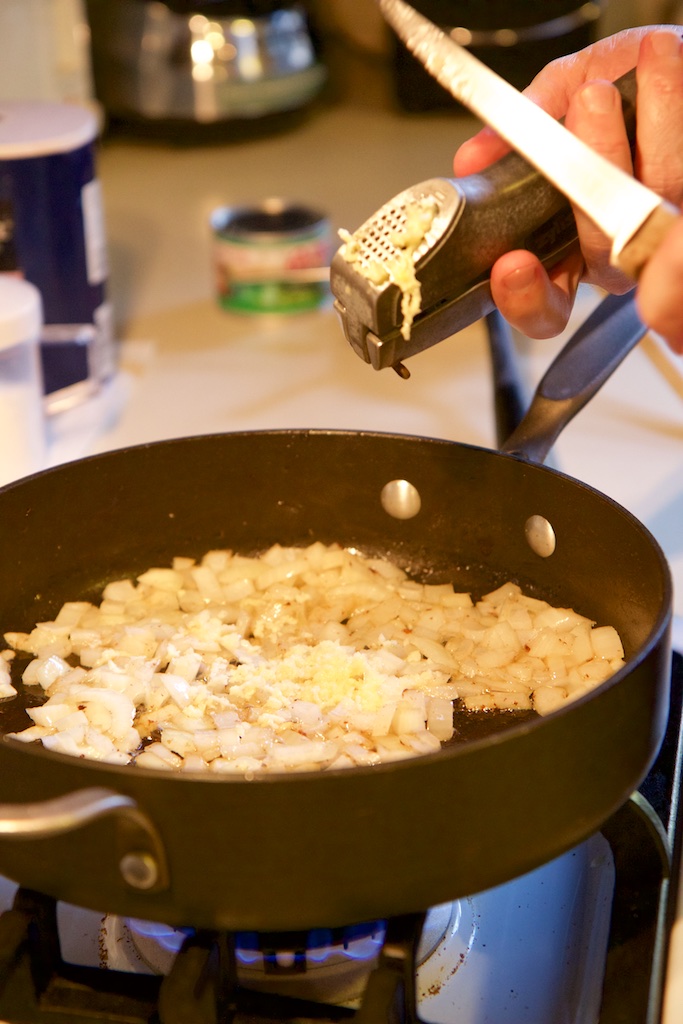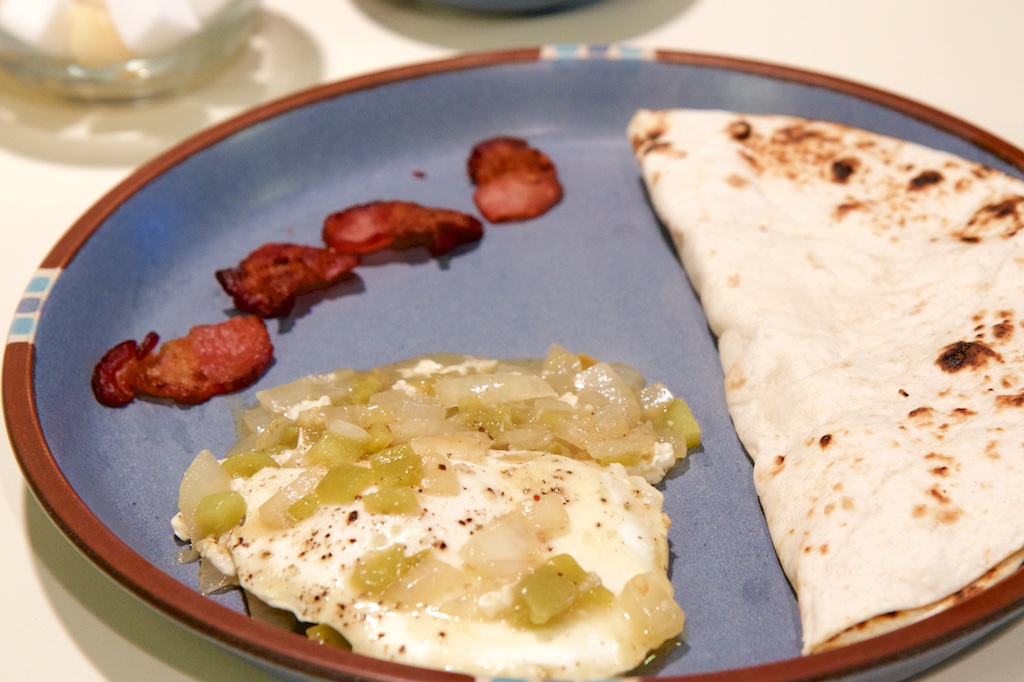
When I first met Professor Paul Canfield, we talked a lot about science.
Well, he talked a lot about science. Coming from a journalism background, I was in unknown territory but fully absorbing everything he had to say (well, at least in that moment – science retention isn’t one of my strong points).
Professor Canfield's research is centered on the design, discovery, growth, and characterization of novel electronic and magnetic materials. Basically, he grows single crystals that make significant contributions to the field of new materials physics. That smartphone in your pocket, or the MRI in the hospital; many of the materials they are made from are likely the result of his, and his peers', research and discovery.
During that first conversation, we had skipped from talking about his research with novel materials to the history of the Ames Laboratory to working in Germany to living in Los Angeles as a 20-something, working on his Ph.D.
Woven into all these topics — somehow — was food and cooking. We’ve had numerous chats since then, which I always look forward to, since I never know what I’m going to learn, or what I may get to eat. And since I’ve gotten to know Professor Canfield relatively well, I’m going to switch to first names for the rest of this story.
A bit about Paul: He is a Distinguished Professor and the Robert Allen Wright Professor of Physics and Astronomy at Iowa State University. He’s also a senior physicist at the Ames Laboratory.
He holds one of the Department of Energy’s highest honors, the Lawrence Award. He holds a David Adler Lectureship Award in the Field of Materials Physics for his outstanding teaching. Recently, he was presented with a prestigious Humboldt Research Award, which recognizes all of his achievements to date, allowing him to collaborate with various research teams in Germany over the next year.
Amidst talking about all these accolades (there are many others), we also talked about how (and what) to cook with quince. About the various ways he preserves the raspberries he harvests from his backyard. About how the slow simmer of a hot stew is the perfect remedy for a chilly winter afternoon — and that small, unripe grapes provide a gloriously sour undertone to said stew.
Indeed, in each conversation with Paul that has followed, something food-related is always thrown in.
At our most recent interview, there was a Tupperware full of neatly stacked brown squares on his desk.
“These are lovely little amaretti chocolates I purchased,” he said. “Are you familiar with amaretti? Unlike amaretto, which is made partly or wholly from almond extract, amaretti cookies or sweets are often made from apricot kernels.”
I had never tasted amaretti, but the flavor combo made my taste buds sing. It was only 8 a.m., but, what the hell. I helped myself to three.

Combining passions
Paul summarized his thoughts about his professional and private passion for lab and kitchen cooking in an essay titled, rightly enough, "A Cook's Tale." This essay was published in one of the premiere journals in his field, Nature Physics, and even has a picture of one of his cakes as part of it. The opening paragraph of the essay explains a lot about Paul's approach to discovery:
“Although I do not create food recipes from scratch as often as I do inorganic ones, I have found that skill or intuition in cooking stems from the same font as skill or intuition in the growing of crystals. Both rely on knowledge based on experience and a willingness to make mistakes and learn from them. After a decade or two’s experience of cooking, you get a sense of when nutmeg will help bring out a flavor in a sauce in much the same way that, after several thousand growths, you can guess that a certain compound should grow out of molten tin. Often when new students want to join my group I will ask them if they like to cook. It’s a useful question; it can startle the students but then leads them to realize that experimental physics, at least in this manifestation, draws on many sorts of impulses or muses.”
As a child, Paul liked to be able to logically derive things. Memorization was “appalling” — he wanted to understand how and why things worked. He calls his career in research the result of the “logical hybridization” of his parents (his mother’s technical skills, his father’s writing and analytical background). When he was prescribed glasses at the age of 8 — a horror for most kids — he was thrilled. “I was so happy because they made me look more ‘scientific,’” he said. “My mother thought I was faking it just so I could get glasses.”
Paul recalls that he had key teachers and inspirations for both the cooking and science sides of his “materials obsessions.”
“In middle school I took a short after school course in cooking,” he recalls. “Although this was probably less than 24 hours total out of my life it had a profound impact. The teacher had a simple and powerful mantra: ‘If you can read, you can cook.’ That has guided me around the world in terms of cuisinal exploration.”
Later, in high school, Paul remembers a “wonderful chemistry teacher who was incredibly tolerant.”
“She let me inventory the stock room and propose various projects,” he said. “I found a book that was basically a book about pyromania. There were lots of explosions — things you couldn't get away with in a classroom today. But she supported it, and she supported the learning that came from it."
“Although I do not create food recipes from scratch as often as I do inorganic ones, I have found that skill or intuition in cooking stems from the same font as skill or intuition in the growing of crystals.
Paul explained that the basic knowledge of what can be substituted in a recipe, or what would make a good pairing, or what might be a more adventurous ingredient to use, is knowledge that can be applied in the lab as well. Undoubtedly, Paul’s natural inquisitiveness paired with past instructors’ willingness to let him explore new things has led to a fruitful career in science.
“As your knowledge builds, you can make some pretty awesome stuff. It's the same concept in materials research,” he said.
Today, teaching, coaching, and giving students' the confidence to achieve in the lab, classroom, and even, sometimes, the kitchen, is still extremely rewarding to him. Of course, his teaching doesn't stop there, hence, the quick amaretti lesson.

The joy of sharing ideas and materials
The amaretti could have been left at, "try these. They're good." But in addition to tasting something new, I actually learned about what I was eating. It's Paul's common approach: Share it; learn it; never just assume something is common knowledge.
He's internationally known for his research and breakthroughs in novel materials, but still teaches Physics 221 (lately, it has been a double course load) — a basic intro course largely comprised of non-physics majors. He worked with undergrads and masters students while on sabbatical in Madrid to build a lab from scratch, providing an awesome opportunity for lesser-experienced students. And alumni who worked with him as Ph.D. students credit his leadership and guidance as part of their success. Perhaps not surprisingly, one of his other awards is a Master Teacher Award from the College of Liberal Arts and Sciences.
In his lab, Paul teaches his students how to develop and discover new materials. Often, the lab book resembles my grandmother’s cookbook — a list of ingredients and a few temperatures and times. The only real difference is that my grandma didn’t use Ytterbium, or heat to 1200 degrees Celsius.
Paul ends his Nature Physics article by returning to the similarity between sharing what you cook and sharing what you discover:
“There is a special joy that comes with trying to understand with a collaborator some seemingly mysterious physical behavior, one that is similar to cooking an elaborate meal to be enjoyed by friends. It is a basic human desire to share and enjoy interesting experiences in good company. At an even broader level, food and physics are about the joy of sharing discovery: long meals with friends, long discussions with colleagues; about what was good and what could be better, memories of past discoveries and hopes for more in the future. Done right, they both contribute to a privileged and deeply satisfying life.”
Today, cooking — both the edible and the inedible — continues to play a role in his ability to effectively teach and share. In addition to the thousands of samples he’s “cooked” in his lab, he has also created and refined hundreds of food recipes. Also an avid traveler, his knowledge of cuisine spans many continents. To corral this breadth of expertise, it is his dream to write his own cookbook.
“What a sabbatical project that would be!” he said.
“What a fantastic edition to my bookshelf that would be,” I think to myself.

Editor’s note: Paul Canfield has a knack for cooking things that are both beautiful and delicious. His research focuses on growing stunning crystals in his lab; his hobby focuses on cooking adventurous cuisine in his kitchen. Here, he provides the recipe for one of his favorite weekend meals.
Eggs Poached in Green Chili with Bacon
An original recipe by Paul Canfield, Distinguished Professor of Physics and Astronomy
When we lived above Los Alamos, N.M., which was around 9000 feet high in the Jemez Mountains, we fell in love with green chile. Over the past year I have been refining the following recipe and it is now a common weekend lunch, served with toasted flour tortillas. It can be prepared in 20-30 minutes, only requires one pan, and serves two for a hearty lunch or four for a light lunch.
Prep time: 20 minutes
Serves: 2-4
Ingredients:
4 strips of bacon (either whole or cut into ¼ lengths)
½ white onion, diced
2 cloves of garlic, chopped or squeezed through a garlic press
2 teaspoons of flour
4.25 oz can of diced green chiles
½ cup of water
4 eggs
4 flour tortillas (toasted over gas flame or warmed as you can)
Directions:
There are three basic steps to this recipe: crisp the bacon, make the green chile sauce, poach the eggs. They can all be done in the same large frying pan.
- First, fry bacon to very crisp. This provides nice, crisp bacon and flavorful drippings for the next step.
- When bacon is crisp, move to a plate to drain on a paper towel. Leave drippings (some or all) in the pan. Add the chopped onion and garlic to the pan and wilt the onions over medium flame, about 5 minutes.
- Once onions soften, sprinkle the flour over them and stir for 30-60 seconds.
- Add the chopped green chilies, then fill the can with water and add the water, too. Mix the sauce well and let simmer about 5 minutes so that it begins to thicken.
- Once the sauce is mixed well and thickened, carefully break the four eggs into the sauce. Allow each egg room to cook in the pan, nestled in the chile sauce. Salt and pepper the eggs lightly. Turn the pan to a medium / low flame, cover, and let eggs and sauce simmer gently.
- Let the eggs cook to your desired yolk hardness. I like the yolk to be rather runny, but you can let it go longer.
- As eggs are cooking, warm / toast the tortillas. Since we have a gas stove, this simply involved holding them over a flame.
- Serve eggs covered with sauce with bacon and toasted tortillas on the side. Enjoy the tortillas as a side to the meal, or use them to build a breakfast burrito from the egg, sauce and bacon.
- Since this is fundamentally a “breakfast” type of meal, I have it with a cup of strong, black coffee, no matter what time of day I eat this.
- Enjoy.